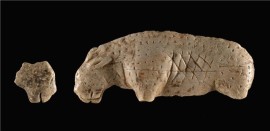A new fragment of the infamous 40,000-year-old Vogelherd Cave lion figurine was recently found by archaeologists from the University of Tübingen.
The new fragment which makes up the head of the alternate side of what was previously thought to be a relief carving proves that the figurine was I fact originally a completely 3-D figurine — not a relief carving as was previously thought.
“The figurine depicts a lion,” explains Professor Nicholas Conard of Tübingen University’s Institute of Prehistory and Medieval Archaeology, and the Senckenberg Center for Human Evolution and Palaeoenvironment Tübingen. “It is one of the most famous Ice Age works of art, and until now, we thought it was a relief, unique among these finds dating to the dawn of figurative art. The reconstructed figurine clearly is a three dimensional sculpture.”
The press release provides more:
The mammoth ivory figurine depicting a lion was discovered during excavations in 1931. The new fragment makes up one side of the figurine’s head, and the sculpture may be viewed at the Tübingen University Museum from 30 July. The new fragment was discovered when today’s archaeologists revisited the work of their predecessors from the 1930s.
Vogelherd is one of four caves in the region where the world’s earliest figurines have been found, dating back to 40,000 years ago. Several dozen figurines and fragments of figurines have been found in the Vogelherd alone, and researchers are piecing together thousands of mammoth ivory fragments.
“We have been carrying out renewed excavations and analysis at Vogelherd Cave for nearly ten years,” states Conard. “The site has yielded a wealth of objects that illuminate the development of early symbolic artifacts dating to the period when modern humans arrived in Europe and displaced the indigenous Neanderthals.” (Authors note: There are a lot of assumptions in that statement…)
Interestingly, the cave is also the site of the discovery of the oldest currently-known-of musical instruments in the world — similar to the 43,000-year-old flutes discovered in Geißenklösterle Cave in southwest Germany.
Of course much of this is likely down to the environment. The simple fact is that not much survives the ravages of such long periods of time, and that’s even given the best of environments with regard to preservation. Much of the time frames placed on different “periods” of “human development” is simply speculation and guesswork.
